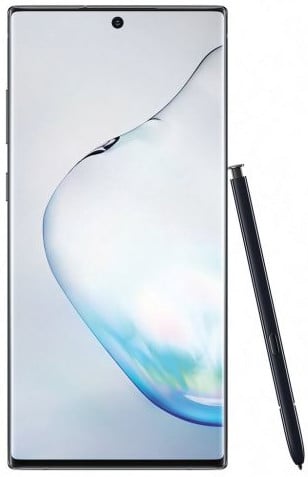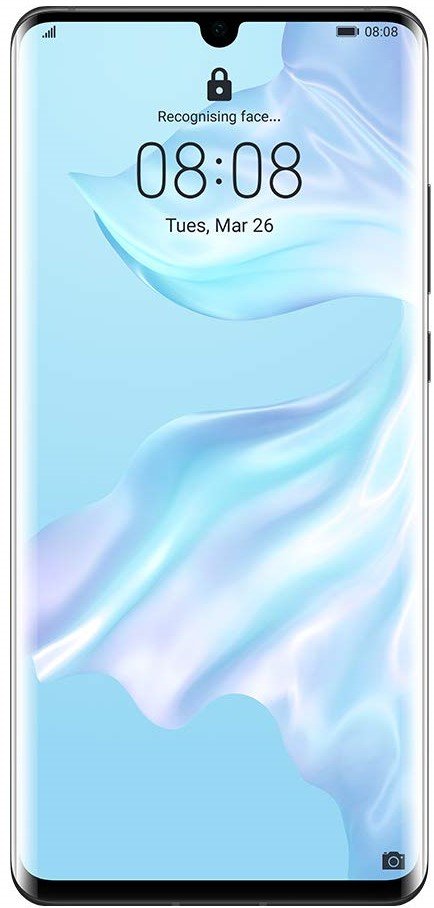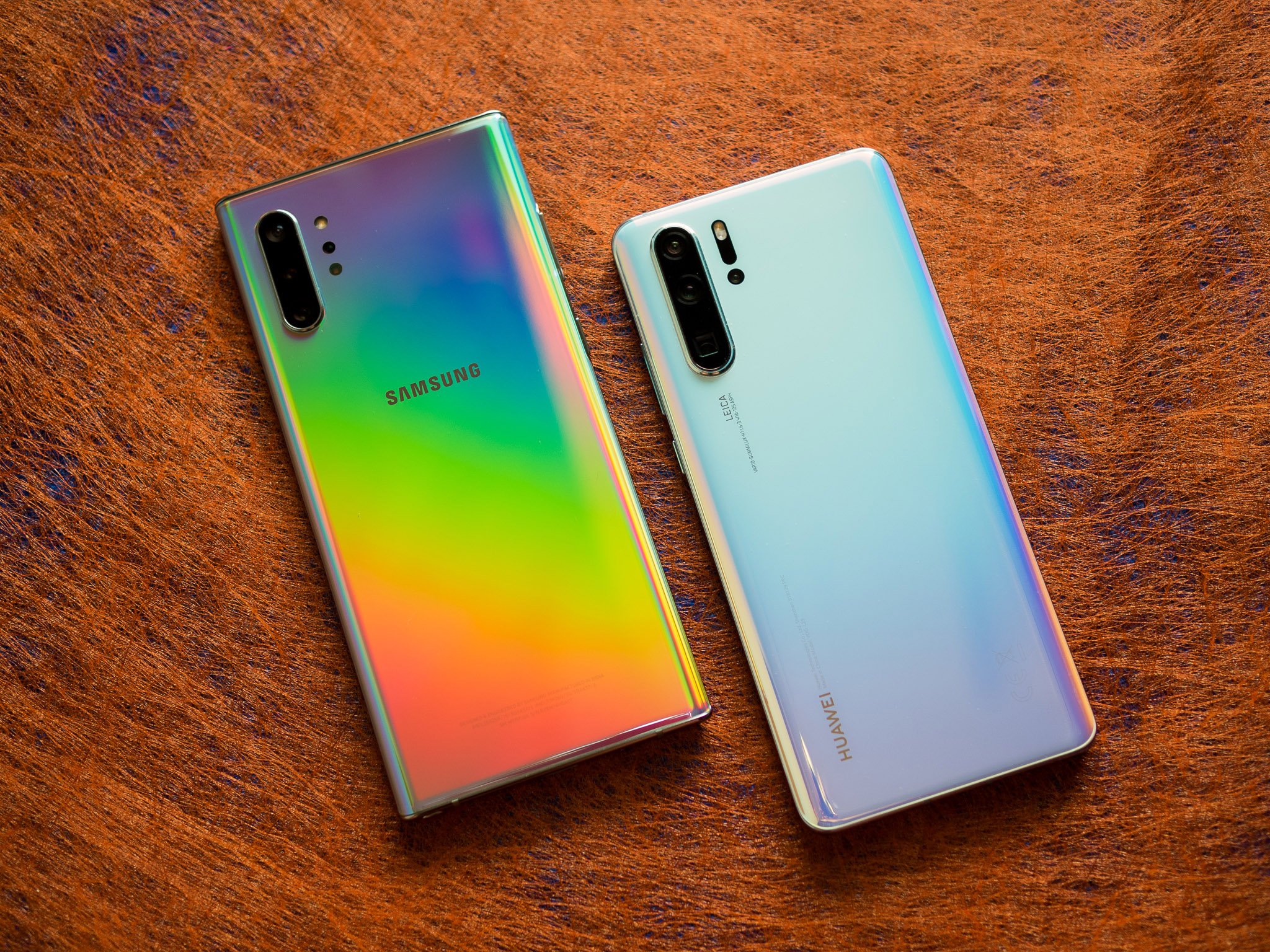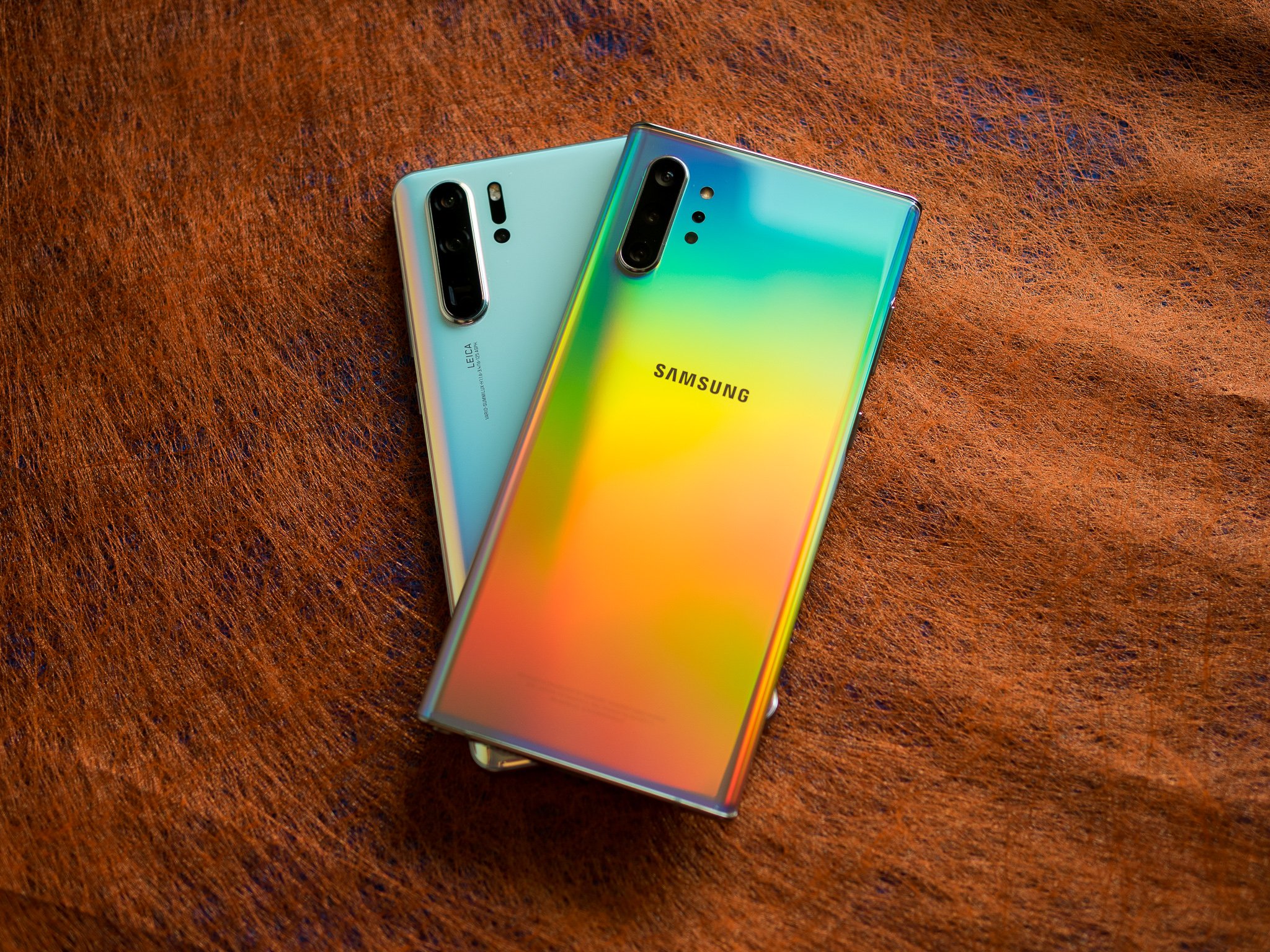The P30 Pro continues to be a great choice in the latter half of 2019, and Samsung is now rolling out its offering aimed at power users in the Galaxy Note 10+. Unable to choose between the two? We're here to lend a hand.
Galaxy Note 10+
Best of Samsung
Pros
- Stunning AMOLED display
- 45W fast charging with 4300mAh battery
- S Pen gets even better
- Top-notch hardware
- MicroSD slot
Cons
- Expensive
- No headphone jack
The Note 10+ packs a ton of new features, including a gradient design and an edge-to-edge AMOLED screen with a cutout at the center for the front camera module. The internal hardware has also been refreshed, the S Pen has picked up more features, and you now get 45W wired charging and 15W wireless charging.
Huawei P30 Pro
Camera champion
Pros
- Gorgeous design
- Outstanding cameras
- 10x lossless zoom
- Two-day battery life
- Latest internal hardware
Cons
- Not sold officially in the U.S.
- No headphone jack
There really isn't a whole lot missing from the P30 Pro. You get a gorgeous design with gradient patterns at the back, the latest internal hardware, a 4200mAh battery that lasts two days, and 40W wired charging. Combine that with the best camera on any phone today and it's easy to see why the P30 Pro is in a league of its own.
Right now, the P30 Pro is one of the best phones money can buy. With a 5x optical zoom lens and two-day battery life, the phone has plenty to offer for those in the market for a high-end device. The Note 10+ is aiming to change that, with Samsung rolling out a host of new features to take on Huawei.
The Note 10+ has a stunning design and exquisite display
Samsung made a lot of changes to the Note 10 series this year, and it's easy to see that some of the new additions — particularly around design and charging — were motivated by Chinese brands. The Note 10+ has a gorgeous new gradient pattern that's one of the most vibrant I've seen on any phone, and it's safe to say that these are two of the best-looking phones in the market today.
Both phones are packed with features, but the Note 10+ takes the lead thanks to that stunning AMOLED panel.
The gradient pattern on the Aura Glow Note 10+ is mesmerizing — the colors shift between various hues as light strikes the glass back, and the effect is very pronounced. The Breathing Crystal variant of the P30 Pro has a similar shimmering effect, and while it is much more subdued, it is striking nonetheless.
Both phones have four cameras at the back, and the sensors are arrayed roughly in the same location. The P30 Pro has both the power and volume buttons on the right, and the power button is located just where your thumb usually rests on the side. The Note 10+, meanwhile, has both buttons on the left, a controversial move as every other major Android device has the power button on the right. What that means is that you'll have to relearn to press the button on the left to wake the screen, and change back whenever you switch to another device. It is infuriating, and Samsung should have known better.
As you can make out from the images above, the Note 10+ is considerably taller and wider than the P30 Pro. That's because of the larger 6.8-inch panel, and when it comes to usability the P30 Pro is the better choice. The rounded corners and narrow frame make it easier to hold and use, but there's no denying that the massive AMOLED panel on the Note 10+ is in a class of its own.
Samsung has led the field when it comes to displays for some time now, and the Note 10+ has a Dynamic AMOLED display that is the best you'll find on any phone today. The QHD+ panel is rated for HDR10+, and Samsung has managed to drastically cut down on the bezels by going with a in-screen camera cutout that's now at the center. The P30 Pro has a great OLED panel, but the FHD+ screen just isn't on the same level as what you get on the Note 10+.
As for the internal hardware, the Note 10+ comes with 12GB of RAM as standard and 256GB of UFS 3.0 storage, with the P30 Pro offering 8GB of RAM and 128GB of UFS 2.1 storage. The Note 10+ is powered by the Snapdragon 855 in the U.S. and China and the Exynos 9825 in global markets, whereas the P30 Pro is fielding the 7nm Kirin 980.
Of course, Samsung's decision to dual-source chipsets — with global variants of the Note 10+ featuring an Exynos chipset — mean the battery life between the Snapdragon 855 and Exynos 9825 models will be marginally different. That said, both of these platforms are manufactured on the 7nm node. In day-to-day usage, the Note 10+ feels just as fluid as the P30 Pro, and you're not going to see any slowdowns on either device. Both phones offer the latest hardware available today, and it shows.
S Pen is the main differentiator for the Note 10+, and it is picking up a few new features this time.
Continuing with the similarities, both phones have IP68 dust and water resistance. Samsung's controversial decision to get rid of the 3.5mm jack on the Note 10+ means neither device has the jack, so you'll have to resort to using a dongle if you plan on using a wired headset.
Of course, the marquee feature for the Note series has been the S Pen, and this time around Samsung is putting more sensors in the stylus and adding a host of new software features. You'll be able to doodle with AR Doodles, use the stylus as a remote shutter button and switch camera modes, and get fine-grained control when editing content in the video editor. The Note 10+ also has Samsung Pay, and while it hasn't received any new features of late, it continues to be the best mobile payments service around.
All the specs you can ask for
Let's get this out of the way: Samsung got rid of the 3.5mm jack on the Note 10+. That's going to be a dealbreaker for a subset of the community, but you do get AKG USB-C earbuds in the box, and the sound quality is on par with the 3.5mm version of the same buds. The P30 Pro is also missing the 3.5mm jack, but if you look past that, there's plenty to like on both phones.
| Category | Samsung Galaxy Note 10+ | Huawei P30 Pro |
|---|---|---|
| Operating system | Android 9.0 Pie One UI 1.5 |
Android 9.0 Pie EMUI |
| Display | 6.8-inch Dynamic AMOLED, 3040x1440 (19.5:9) HDR10+ |
6.47-inch OLED 2340x1080 (19.5:9) HDR10 |
| Chipset | Snapdragon 855 (U.S., China) Exynos 9825 (ROW) |
HiSilicon Kirin 980 2 x 2.6GHz Cortex A76 2 x 1.92GHz Cortex A76 4 x 1.8GHz Cortex A55 Mali-G76 MP10 7nm |
| RAM | 12GB LPDDR4X | 8GB LPDDR4X |
| Storage | 256GB/512GB UFS3.0 | 128GB/256GB/512GB UFS2.1 |
| MicroSD slot | Yes | No (Nano Memory) |
| Rear camera 1 | 12MP f/1.5-2.4, OIS 77° FoV |
40MP, f/1.6 OIS Dual Pixel PDAF |
| Rear camera 2 | 12MP, f/2.1, OIS telephoto 45° FoV |
20MP, f/2.2 Wide-angle |
| Rear camera 3 | 16MP, f/2.2 Wide-angle 123° FoV |
8MP 5x optical zoom 10x digital zoom |
| Rear camera 4 | VGA f/1.4, 72° FoV | TOF 3D |
| Front camera | 10MP, f/2.2, 80° FoV auto focus |
32MP, f/2.0 HDR |
| Connectivity | Wi-Fi ax MU-MIMO, Bluetooth 5.0 LE NFC, AptX HD, A-GPS |
Wi-Fi ac, Bluetooth 5.0 NFC, AptX HD, A-GPS |
| Audio | USB-C Stereo speakers |
USB-C Single speaker |
| Battery | 4300mAh Non-removable |
4200mAh Non-removable |
| Charging | USB-C PD3.0 Fast charge (45W) |
USB-C 1.0 Fast charge (40W) |
| Water resistance | IP68 | IP68 |
| Security | In-display fingerprint sensor Face unlock |
In-display fingerprint sensor Face unlock |
| Dimensions | 162.3 x 77.2 x 7.9 mm 196g |
158 x 73.4 x 8.4 mm 192g |
| Colors | Aura Glow, Aura White, Aura Black, Aura Blue | Aurora, Amber Sunrise, Breathing Crystal, Black |
The P30 Pro has a better camera and outstanding battery life
Both the Galaxy Note 10+ and P30 Pro have four cameras at the back, but aside from the addition of the DepthVision module, Samsung is using the same sensors as the Galaxy S10+. That already puts it at a disadvantage to the P30 Pro, because when I compared the Galaxy S10+ to the P30 Pro earlier this year, I found that the S10+'s camera wasn't quite on the same level as Huawei. That's particularly the case when it comes to the zoom lens, with Huawei's 5x zoom lens unmatched right now.
Galaxy Note 10+ on the left, P30 Pro on the right.
The Note 10+ has better dynamic range in daylight scenarios, but the resultant images often tend to be oversaturated. Shots from the P30 Pro have more accurate colors, and in low light or any kind of artificial lighting, the device pulls ahead with ease.
Images from the wide-angle lens on the Note 10+ have more detail, but the color accuracy is off. The P30 Pro, meanwhile, takes accurate photos, but the sensor itself isn't quite on the same leve as what you get on the Note 10+.
When it comes to portrait shots, I prefer the Note 10+. The P30 Pro tends to brighten parts of the photo, making it look less natural. Overall though, the P30 Pro takes the lead for its versatility and low-light prowess. That said, we're talking about slender margins here.
There's a more substantial difference, however, when we're talking about the battery side of things. The Note 10+ has a larger 4300mAh battery versus the 4200mAh unit on the P30 Pro, but because of the power-hungry AMOLED panel, the phone manages to deliver just a day's worth of use from a full charge. The P30 Pro, meanwhile, easily lasts two days.
A key change this time around is with battery tech. Samsung is finally making the switch to 45W wired charging on the Note 10+, overtaking Huawei's 40W standard. That said, the bundled charger for the Note 10+ only goes up to 25W, so you'll have to buy a USB-C PD charger to unlock the 45W charging speeds. On the P30 Pro, the bundled wall plug charges at 40W. Both devices have 15W wireless charging, as well as the ability to wirelessly charge other devices.
All square on the software front
Huawei has made huge strides in making EMUI more palatable to a Western audience in the last 12 months, including an app drawer. The P30 Pro absolutely flies at day-to-day tasks, and the interface no longer feels bloated. That said, there are lingering issues with the lock screen — music playback controls and active calls don't show up — but overall EMUI is no longer a reason to not get the P30 Pro.
Samsung has similarly tweaked a lot of elements, with One UI offering a modern design with a predominantly white interface interlaced with blue accents. It's clear Samsung focused on usability with One UI, and while the interface is definitely a step in the right direction, it doesn't feel cohesive yet.
When it comes to updates, Samsung edges out Huawei on the basis of security updates. The manufacturer consistently rolls out security patches and bug fixes, but both brands are on an equal footing when it comes to platform updates.
It comes down to where you live
Choosing between these two phones comes down to where you live. If you're in the U.S., the Note 10+ is your only option as the P30 Pro isn't officially available in the country. That said, you can find the global variant of the device on Amazon U.S. for under $800, making it an enticing option.
Need all the features? The Note 10+ is the obvious pick. If you want a zoom lens, get the P30 Pro.
The Note 10+, meanwhile, retails for $1,100. You do get 12GB of RAM and 256GB of storage, a display that is outstanding, the latest internal hardware, and a 4300mAh battery with 45W charging. Then there's the S Pen, which has been a standout for the Note series for several years now. And while $1,100 is a crazy amount of money to pay for a phone, Samsung dominates the field in a few categories: particularly the display and the stylus.
It's easy to make a case for the P30 Pro. It doesn't have a Quad HD panel or 12GB of RAM, but in day-to-day usage it's just as fast as the Note 10+, and right now it has the camera to beat on Android. The main 40MP camera on its own is stellar, but when you combine that with the zoom lens, you get a package that's hard to beat.
If you want all the latest features and intend to use the stylus, the Note 10+ is a fantastic choice. If you're instead looking for a phone that has the best camera, the P30 Pro is the way to go.
Galaxy Note 10+
Best of Samsung
Gorgeous new design, same great stylus.
The Galaxy Note 10+ packs all the features you want in a stunning new design that makes it one of the best-looking phones today. The S Pen continues to be a standout feature on the Note series, you get a fantastic AMOLED panel, and 45W charging is the icing on the cake.
Huawei P30 Pro
Camera champion
The camera to beat on Android.
The P30 Pro gets a lot right, but it doesn't have quite as many features as the Note 10+. But it more than makes up for it with the 40MP camera at the back, as well as the 5x optical zoom lens. You lose out on the warranty as the phone isn't sold in the U.S., but it's worth springing for the P30 Pro just for the camera alone.


























Tidak ada komentar:
Posting Komentar